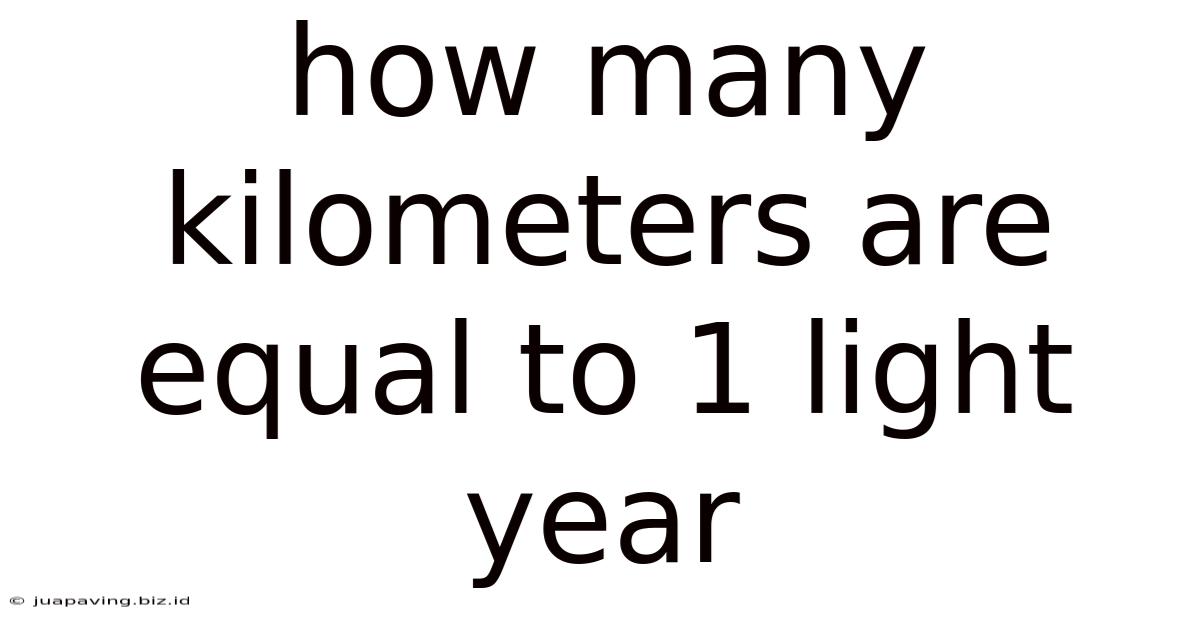How Many Kilometers Are Equal To 1 Light Year
Juapaving
May 10, 2025 · 4 min read

Table of Contents
How Many Kilometers are Equal to 1 Light Year? Unraveling the Cosmos
The vastness of space is almost incomprehensible to the human mind. We measure distances on Earth in meters, kilometers, and sometimes miles. But when we venture into the cosmos, these units become laughably small. To comprehend the distances between stars and galaxies, we need a different scale: the light-year. So, how many kilometers are actually in a single light-year? Let's dive into the fascinating world of astronomical distances and unravel this cosmic calculation.
Understanding the Concept of a Light-Year
A light-year isn't a measure of time, as the name might misleadingly suggest. Instead, it's a measure of distance. Specifically, it's the distance light travels in one Earth year. Light, the fastest thing in the universe, travels at an incredible speed: approximately 299,792,458 meters per second (approximately 300,000 kilometers per second). This seemingly insignificant difference in the number actually impacts the final result, so precision matters.
The Speed of Light: A Cosmic Constant
The speed of light (often represented by the letter 'c') is a fundamental constant in physics. It's not just the speed at which light travels; it's the speed limit of the universe. No information or object can travel faster than the speed of light. This fundamental principle governs our understanding of relativity and the workings of the cosmos.
Calculating the Kilometers in a Light-Year: The Math
To calculate the number of kilometers in a light-year, we need to consider the speed of light and the duration of a year.
- Speed of light: Approximately 299,792,458 meters per second.
- Seconds in a minute: 60 seconds
- Minutes in an hour: 60 minutes
- Hours in a day: 24 hours
- Days in a year: This is where it gets slightly tricky. A year isn't exactly 365 days. For the sake of precision in our calculation, we'll use the Julian year, which is 365.25 days. This accounts for leap years.
Now, let's perform the calculation step-by-step:
-
Seconds in a year: 365.25 days/year * 24 hours/day * 60 minutes/hour * 60 seconds/minute = 31,557,600 seconds/year
-
Meters in a light-year: 299,792,458 meters/second * 31,557,600 seconds/year = 9,460,730,472,580,800 meters/year
-
Kilometers in a light-year: Since there are 1000 meters in a kilometer, we divide the result by 1000: 9,460,730,472,580,800 meters / 1000 meters/kilometer = 9,460,730,472,580.8 kilometers
Therefore, approximately 9.461 × 10<sup>12</sup> kilometers are equal to one light-year. This is a staggeringly large number, highlighting the immense scale of interstellar distances.
Visualizing the Immensity: Comparing Light-Years to Familiar Distances
To truly grasp the sheer magnitude of a light-year, let's compare it to distances we're more familiar with:
1. The Circumference of the Earth:
The Earth's circumference is approximately 40,075 kilometers. A light-year is over 235 million times greater than the Earth's circumference.
2. The Distance to the Moon:
The average distance to the Moon is about 384,400 kilometers. A light-year is roughly 24.6 million times farther than the Moon.
3. The Distance to the Sun:
The average distance to the Sun (one astronomical unit or AU) is about 149.6 million kilometers. A light-year is about 63,240 times farther than the Sun.
These comparisons illustrate how incredibly vast a light-year truly is. It's a unit of measurement necessary for navigating the cosmic distances between stars and galaxies.
Beyond Light-Years: Exploring Larger Cosmic Scales
While light-years are useful for measuring distances within our galaxy, even they pale in comparison to the distances between galaxies. For intergalactic distances, astronomers use even larger units like:
- Parsecs: One parsec is approximately 3.26 light-years.
- Kiloparsecs (kpc): 1000 parsecs
- Megaparsecs (Mpc): 1 million parsecs
These larger units allow astronomers to describe the immense distances separating galaxies across the observable universe.
The Light-Year in Popular Culture and Science Fiction
The light-year has permeated popular culture, often featured in science fiction stories and films to convey the vastness of space and the challenges of interstellar travel. While often used loosely in fiction, understanding the actual distance represented by a light-year adds depth and realism to these narratives.
Conclusion: A Journey into the Cosmic Scale
Understanding the conversion of light-years to kilometers is essential for appreciating the sheer scale of the universe. While the number itself is daunting – approximately 9.461 × 10<sup>12</sup> kilometers – the implications are profound. It underscores the immense distances between celestial objects and the challenges and opportunities that lie in exploring the cosmos. The light-year serves not only as a unit of measurement but as a reminder of the vastness of space and the ongoing quest to understand our place within it. By grasping this concept, we take a significant step towards comprehending the incredible expanse and wonder of the universe.
Latest Posts
Latest Posts
-
Ab And O Blood Type Offspring
May 10, 2025
-
Difference Between Anaphase 1 And Anaphase 2
May 10, 2025
-
Final Electron Acceptor In Electron Transport Chain
May 10, 2025
-
Classify Statements About Total Internal Reflection As True Or False
May 10, 2025
-
How Can You Tell A Chemical Reaction Has Taken Place
May 10, 2025
Related Post
Thank you for visiting our website which covers about How Many Kilometers Are Equal To 1 Light Year . We hope the information provided has been useful to you. Feel free to contact us if you have any questions or need further assistance. See you next time and don't miss to bookmark.